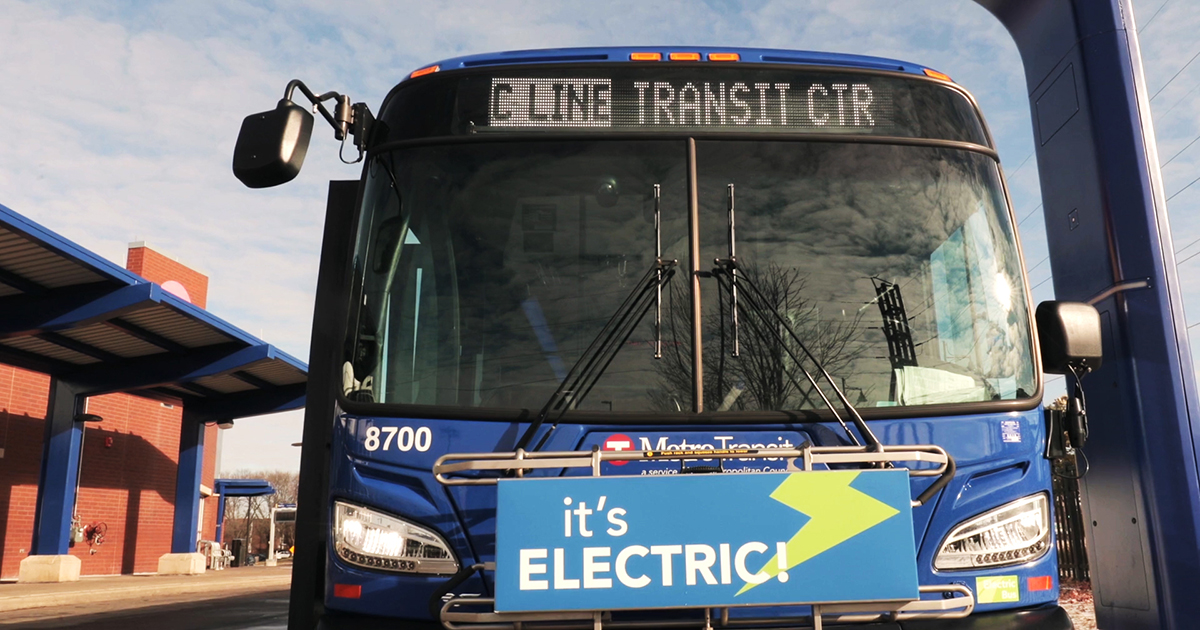VIDEO: MN-Made Electric Buses Charged to Combat Climate Change
“This is truly zero emission. It’s quiet, it’s clean, and it’s making the world a better place.” That’s the way Jacob Zipp, of New Flyer of America, describes the electric buses they are building here in Minnesota.
He’s right! Transit makes the world a better place in so many ways. One of the biggest: transit is one of the best tools we have to reduce the climate pollution and air pollution that comes from transportation.
A typical diesel bus produces far fewer climate emissions compared to driving alone: 33 percent less when the bus is only about a quarter full and 82 percent less when you’ve got a full bus carrying 40 people. And zero-emission buses that run on electricity instead of fossil fuels can make that already solid equation even better.
Every amount of climate pollution avoided brings us one step closer to a stable future. And every reduction in air pollution means more kids can grow up breathing clean air, lightening the burden of respiratory illness and other negative health impacts, especially in communities of color and low-income communities in Minnesota.
To stop the climate crisis and answer the call for environmental justice, we have to do all we can. Our cities and state absolutely cannot achieve climate reduction goals without major growth in transit ridership and reductions in driving, and we all must continue to support rapid electrification of the transportation sector as well.
Some of this electrification already is happening right here in Minnesota. Metro Transit is running all-electric buses on the C Line bus rapid transit route in Minneapolis and Brooklyn Center that were manufactured by New Flyer—a company that has been making fully electric buses in St. Cloud and Crookston since 2017. These buses serve transit systems here and around the country, all while supporting local jobs in our state.
It’s not just the buses making a difference—so are the people who build them. As Jacob Zipp describes: “I got my first chance to do electric buses when we were assigned to do the Minneapolis/Metro Transit build. Being able to be there with the whole community around us and actually hear a genuine excitement about what we built for them and how it’s going to improve their lives. . . it was really amazing.”
Having New Flyer buses produced in Minnesota means that the benefits of transit investments can be even more impactful. New Flyer’s production supports 800 jobs between their St. Cloud and Crookston plants, and these jobs are skilled labor positions with transferable skills for our technology-heavy economy. And as one of our past reports shows, the job benefits to Minnesotans extend even further up the supply chain, with assembly, suppliers, and manufacturers spread throughout the state.
Here in the Twin Cities region, we encourage and expect Metro Transit to continue their investments in electric buses to clean our air and secure our future. In 2018, after a push from local advocates and allies, the agency announced a plan to transition their entire bus fleet to electric buses, with a goal to purchase no more diesel vehicles starting in 2022. This aligns with the Metropolitan Council’s commitment to power Metro Transit and all its operations with renewable energy by the year 2040, but spending on electric buses has so far been limited by lack of funds.
Continuing the shift to electric buses is a critical part of getting polluting fossil fuels out of our transportation systems and our communities. People need clean air to breathe and a stable climate to live. They need jobs and a way to get there. It’s really that simple. And on all fronts, an investment in electric buses delivers. One more reason to ensure our transit systems have the resources they need to move us forward.
A short and inspiring video shared by our friends at Clean Energy Resource Teams highlights the electric C Line buses, the team at New Flyer, and the exciting potential of electric buses both to eliminate harmful tailpipe emissions and to create green jobs. Shot pre-COVID, the video is part of The Power of Minnesota series. Take a look below!

